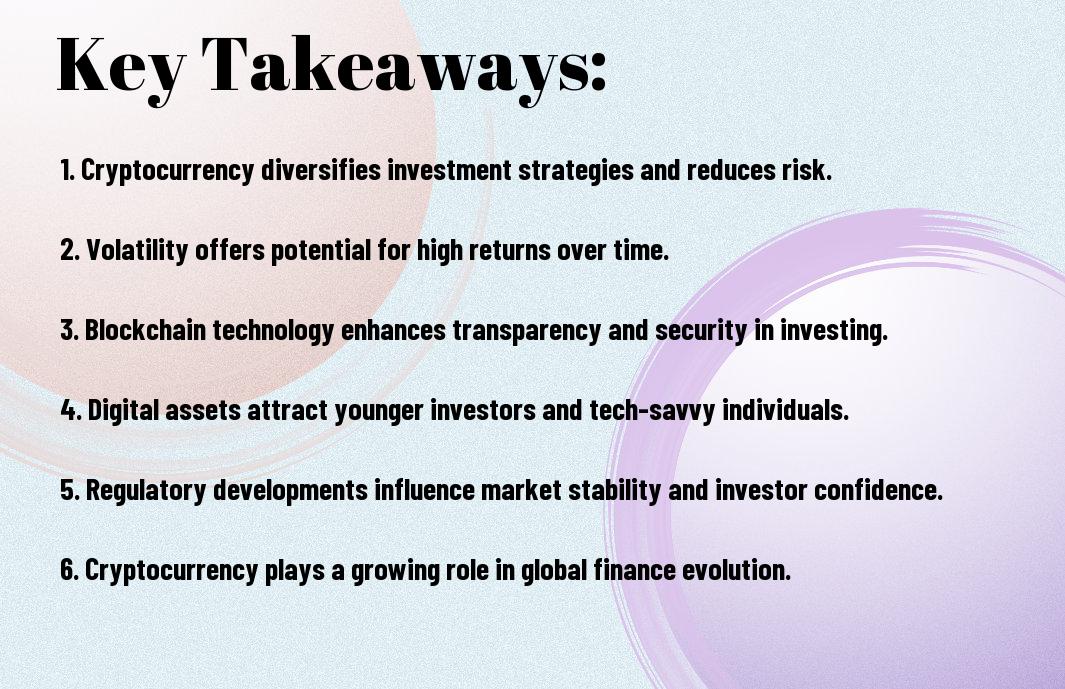Many investors seek to create robust portfolios that can weather market fluctuations, and incorporating real estate is an effective strategy to achieve this. By allocating a portion of your investments to real estate, you can benefit from potential income generation, property appreciation, and a hedge against inflation. Diversifying with real estate not only helps reduce overall risk but also enhances the potential for long-term financial growth. In this post, we will explore the various ways real estate contributes to a well-rounded investment portfolio and why you should consider it in your financial planning.
Key Takeaways:
- Risk Mitigation: Incorporating real estate can help reduce overall portfolio volatility by providing a hedge against market fluctuations.
- Income Generation: Real estate investments often yield reliable income streams through rental returns, adding extra cash flow to a diversified portfolio.
- Inflation Hedge: Real estate usually appreciates over time and can act as a safeguard against inflation, preserving purchasing power for investors.

Understanding Real Estate as an Asset Class
A diving deep into real estate as an asset class reveals its significance in Real Estate Portfolio Diversification. This tangible asset offers unique benefits such as the potential for consistent cash flow, appreciation, and tax advantages, making it a vital component in your diversified investment portfolio.
Characteristics of Real Estate Investments
Among the key characteristics of real estate investments are their ability to generate cash flow, provide tax benefits, and offer the potential for appreciation over time. They also tend to have lower volatility compared to stocks.
| Characteristic | Description |
| Cash Flow | Income generated from rentals. |
| Tax Benefits | Deductions for depreciation and expenses. |
| Appreciation | Increase in property value over time. |
| Low Volatility | Less price fluctuation than stocks. |
| Leverage | Ability to use borrowed funds. |
Types of Real Estate Investments
Types of real estate investments vary widely and can suit different investment strategies. These include residential, commercial, industrial, and real estate investment trusts (REITs), each offering distinct advantages and risks.
| Type | Description |
| Residential | Single-family homes and multi-family units. |
| Commercial | Office buildings, retail spaces, and hotels. |
| Industrial | Warehouses and manufacturing facilities. |
| REITs | Companies that own or finance real estate. |
| Raw Land | Undeveloped parcels for future use. |
Types of real estate investments offer various paths for wealth creation, and they cater to your unique goals and risk tolerance. By exploring options such as residential, commercial, or industrial properties, you can tailor your investment strategy effectively.
- Residential properties provide steady rental income.
- Commercial properties may yield higher returns.
- Industrial spaces offer robust demand in logistics.
- REITs enable easy investment in diversified portfolios.
- Raw land may appreciate significantly over time.
Any approach requires informed decision-making to maximize your returns.
Benefits of Including Real Estate in Portfolios
While many investors overlook real estate, incorporating it into your portfolio offers numerous advantages. It provides a tangible asset that can help enhance returns, generate passive income through rental yields, and offer potential tax benefits. By integrating real estate into your investment strategy, you can create a more resilient portfolio that can withstand market fluctuations and increase overall financial stability.
Diversification and Risk Reduction
After including real estate in your portfolio, you can achieve greater diversification. Real estate often behaves differently than stocks and bonds, which helps to reduce overall portfolio risk. By spreading your investments across various asset classes, you can better protect yourself against volatility and unexpected market downturns.
Inflation Hedge
Against rising inflation, real estate serves as a reliable hedge. As the costs of goods and services increase, so typically do property values and rental income. This correlation means that your investments in real estate can help maintain, and in some cases, even increase your purchasing power over time.
Reduction in the value of money due to inflation can erode the real returns of cash or fixed-income investments. By investing in real estate, you position yourself to benefit from property appreciation and rental increases, which generally keep pace with or exceed the rate of inflation. This characteristic not only safeguards your wealth but also enhances your overall investment strategy by providing an asset that tends to hold its value in inflationary environments.
Potential Risks and Challenges
After incorporating real estate into your diversified portfolio, it’s important to remain aware of the potential risks and challenges associated with this asset class. Market fluctuations can affect property values, leading to unpredictable returns. Additionally, maintaining a real estate investment requires diligent management and an understanding of market dynamics.
Market Volatility
Besides the inherent value of your properties, market volatility can significantly impact your investment. Economic shifts, interest rate changes, and local market dynamics can lead to sudden drops in property values, affecting your overall portfolio performance. Staying informed about these trends is important for mitigating risks.
Illiquidity and Management Issues
About illiquidity, real estate investments are not as easily tradable as stocks or bonds, making them less liquid. Your ability to quickly access cash through these assets can be limited, especially during economic downturns. Furthermore, effective management of properties requires time, expertise, and often additional financial resources to maintain or improve them.
The illiquidity of real estate can pose significant challenges when you need to realize cash quickly or when facing unexpected expenses. This makes it important to factor in a buffer for your finances, ensuring that your other investments can cover short-term liquidity needs. Additionally, the management aspect might require you to hire professionals, increasing your operational costs. A thorough understanding of these issues will help you navigate the complexities of your real estate investments more effectively.
Strategies for Incorporating Real Estate
All investors should consider various strategies when incorporating real estate into their diversified portfolios. Whether you opt for direct ownership, Real Estate Investment Trusts (REITs), or funds, each strategy offers unique advantages and risks that can align with your overall investment goals. By understanding these options, you can effectively enhance your portfolio’s resilience and potential for returns.
Direct Ownership vs. REITs
The choice between direct ownership of real estate and investing in REITs depends on your individual preferences and investment objectives. Direct ownership allows you to engage in tangible assets, giving you control over management and rental income. In contrast, REITs provide a more liquid option, allowing you to invest in real estate without the challenges of property management, while still gaining exposure to the real estate market.
Real Estate Funds and ETFs
Direct investments in real estate can require substantial capital and ongoing hands-on management. Alternatively, real estate funds and exchange-traded funds (ETFs) offer a diversified approach by pooling money with other investors to invest in a portfolio of real estate assets. This method gives you the benefits of professional management, reduced risk through diversification, and often lower minimum investment requirements compared to purchasing properties directly.
Funds and ETFs allow you to invest in a range of properties, including residential, commercial, and industrial, without the burdens of direct ownership. This option can be particularly appealing if you’re looking to gain exposure to real estate while keeping your investment process streamlined and efficient. By selecting funds or ETFs that align with your investment objectives, you can potentially enhance your portfolio’s performance and stability, all while enjoying greater liquidity compared to traditional real estate investments.

Case Studies: Successful Real Estate Integration
Once again, let’s explore some compelling case studies that showcase successful integration of real estate into diversified portfolios:
- KKR Global Real Estate: Achieved 12% annual returns over 10 years through strategic diversification.
- BlackRock: Generated a 9% increase in portfolio value by allocating 15% to alternative real estate assets.
- Brookfield Asset Management: Reported a 10% boost by focusing on industrial and logistics properties.
- Prologis: Registered 13% returns in REITs factoring in e-commerce growth in 2019.
For in-depth insights, check out Diversification: A Key to Playing the Global Real Estate ….
Long-term Investment Perspectives
The integration of real estate into your investment portfolio provides a stable source of income and capital appreciation over time. It serves as a hedge against inflation while balancing overall risk, making it a highly favorable long-term investment choice.
Short-term Market Effects
Studies indicate that real estate, particularly in urban areas, can be sensitive to short-term market fluctuations, impacting overall portfolio performance more significantly during economic downturns. Understanding these market dynamics allows you to make informed decisions.
Market volatility can cause temporary price declines, forcing you to evaluate your investment strategy. You may find that short-term disruptions, while unsettling, present opportunities to acquire undervalued assets. This understanding fosters resilience in your portfolio, ultimately enhancing its performance over time.
The Future of Real Estate in Investment Portfolios
Despite current market fluctuations, the role of real estate in investment portfolios is expected to evolve significantly over the coming years. As you consider your investment strategies, understanding how real estate can adapt to changes in technology, market preferences, and economic conditions will be key to maintaining a diverse and resilient portfolio.
Emerging Trends and Technologies
Before stepping into the future of real estate, it’s important to acknowledge emerging trends and technologies reshaping the landscape. Innovations such as artificial intelligence, big data analytics, and blockchain are changing how investors analyze properties, streamline transactions, and forecast market movements. Embracing these technologies can enhance your decision-making and optimize your investment outcomes.
Predictions for Market Growth
Future indications suggest a bullish outlook for the real estate market, driven by rising demand across various sectors, such as residential, commercial, and industrial properties. Understanding demographic shifts, urbanization trends, and economic recovery factors will help you position your investments effectively to capitalize on potential growth opportunities.
Estate analysts predict that sustained growth in the real estate sector will arise from several factors, including increasing interest rates, a shortage of housing in urban centers, and a renewed focus on sustainable development. As the market matures, you may observe new opportunities in niches like affordable housing and eco-friendly properties. Staying ahead of these trends can enhance your portfolio’s resilience and yield potential long-term benefits.
Summing up
Taking this into account, you can see that incorporating real estate into your diversified portfolio enhances your investment strategy. By adding real estate, you not only gain access to a unique asset class that often behaves differently from stocks and bonds, but you also create opportunities for passive income and long-term capital appreciation. As market conditions fluctuate, having this tangible asset in your portfolio can help mitigate risks and stabilize overall returns. Ultimately, it’s an intelligent step towards achieving financial stability and growth.
FAQ
Q: Why is real estate considered an important asset class for diversified portfolios?
A: Real estate is regarded as a key asset class because it tends to behave differently than stocks and bonds, providing a hedge against volatility in traditional markets. The income generated through rental yields, coupled with the potential for property value appreciation, offers investors both cash flow and capital growth. When included in a diversified portfolio, real estate can help mitigate overall risk by balancing asset performance during economic fluctuations.
Q: How can investors add real estate to their portfolios without directly purchasing properties?
A: Investors can gain exposure to real estate without direct property ownership through vehicles such as Real Estate Investment Trusts (REITs), real estate mutual funds, and exchange-traded funds (ETFs) that focus on real estate sectors. These investment options allow individuals to invest in real estate markets, receive dividends, and participate in property appreciation without the responsibilities of managing physical properties. These methods provide liquidity and diversification within one’s portfolio.
Q: What are the potential risks associated with including real estate in a diversified portfolio?
A: While real estate offers numerous benefits, it also comes with certain risks. Market fluctuations can affect property values, and real estate can be less liquid than stocks and bonds, meaning it may take longer to sell an asset if needed. Additionally, factors such as interest rates, local market conditions, and economic downturns can impact real estate performance. Investors should conduct thorough research and consider their strategy when integrating real estate into their investment approach.


